Set Theory for SQL Joins
Sample Tables
Here is the schema for the sample World table:
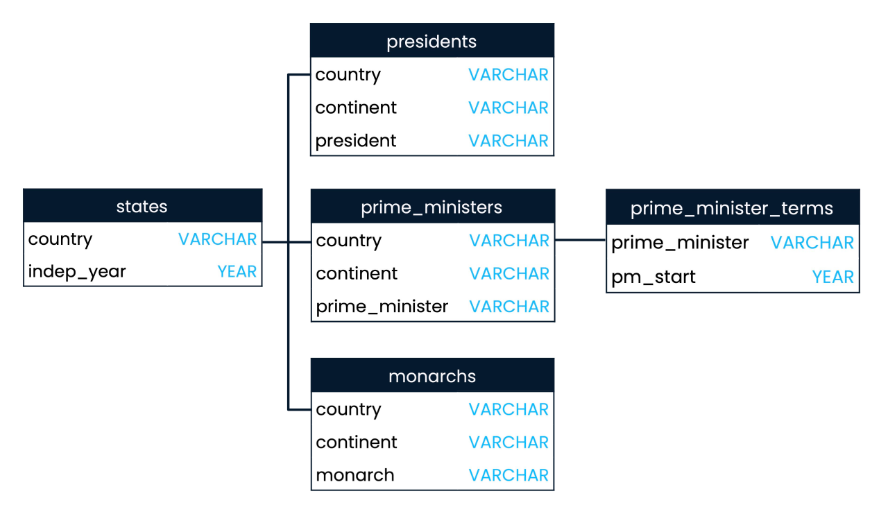
To download the actual files, you can get them from my Github repository:
Set Operations and Venn Diagrams
SQL includes three main set operations: UNION, INTERSECT, and EXCEPT. These operations can be visualized using Venn diagrams, where each circle represents a table. The areas shaded show the results of what is included after applying the set operations to the tables.
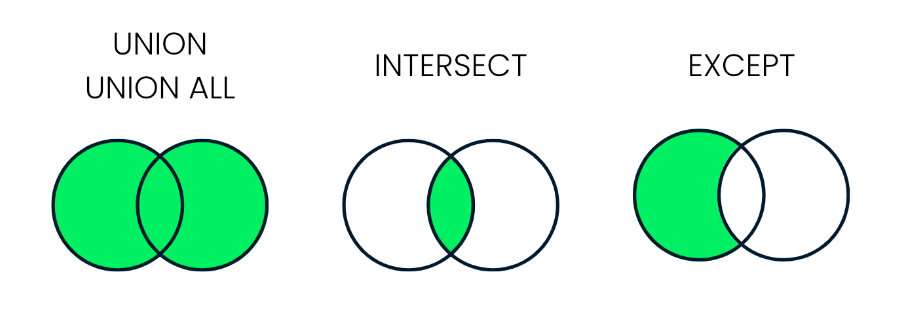
UNION
The UNION operator combines records from two tables but removes duplicate records. For example, if you have two tables, left and right, performing a UNION will include all unique records from both tables. If records are identical, UNION will keep only one instance of each.

Syntax:
SELECT *
FROM left_table
UNION
SELECT *
FROM right_table;
UNION ALL
Unlike UNION, UNION ALL includes all records from both tables, including duplicates. So, using UNION ALL will give you every record from both tables, even if there are duplicates.
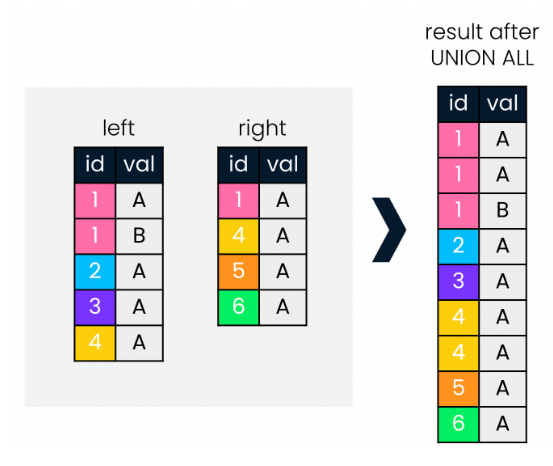
Syntax:
SELECT *
FROM left_table
UNION ALL
SELECT *
FROM right_table;
Note that the columns selected from both tables must be the same in number and data type. For instance, we can't stack a number field on top of a character field.
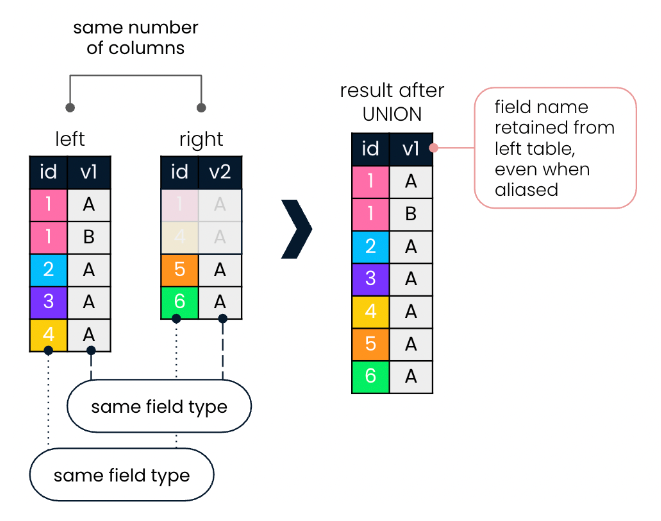
Examples of Union
Use UNION to combine records from the monarchs and prime_ministers tables. This will display the prime ministers and monarchs.
SELECT monarch AS leader, country
FROM monarchs
UNION
SELECT prime_minister AS leader, country
FROM prime_ministers
ORDER BY country, leader
LIMIT 10;
Output:
| leader | country |
|---|---|
| Scott Morrison | Australia |
| King Philippe | Belgium |
| Justin Trudeau | Canada |
| Narendra Modi | India |
| Emperor Naruhito | Japan |
| Yoshihide Suga | Japan |
| Jacinda Ardern | New Zealand |
| Cyril Ramaphosa | South Africa |
| King Felipe VI | Spain |
| Queen Elizabeth II | United Kingdom |
To list all monarchs who also acted as prime ministers, we can use UNION ALL.
SELECT monarch AS leader, country
FROM monarchs
UNION ALL
SELECT prime_minister AS leader, country
FROM prime_ministers
ORDER BY country, leader
LIMIT 10;
| leader | country |
|---|---|
| Scott Morrison | Australia |
| King Philippe | Belgium |
| Justin Trudeau | Canada |
| Queen Elizabeth II | United Kingdom |
| Narendra Modi | India |
| Emperor Naruhito | Japan |
| Emperor Naruhito | Japan |
| Yoshihide Suga | Japan |
| Jacinda Ardern | New Zealand |
| Cyril Ramaphosa | South Africa |
| King Felipe VI | Spain |
INTERSECT
The INTERSECT operation takes two tables and returns only the records that exist in both tables. Using Venn diagrams, you can visualize this by seeing where the two circles overlap.

Imagine two tables: left_table and right_table. When you perform an INTERSECT, the result is the common records between the two tables. Any records not present in both tables are excluded from the result.
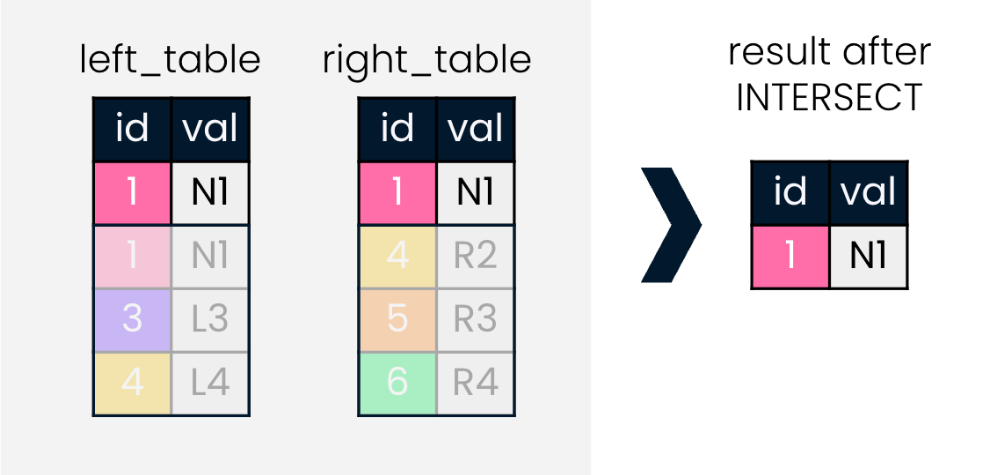
The syntax for INTERSECT is quite similar to UNION and UNION ALL:
SELECT column1, column2, ...
FROM left_table
INTERSECT
SELECT column1, column2, ...
FROM right_table;
Explanation:
- Perform a
SELECTon the first table. - Perform a
SELECTon the second table. - Use
INTERSECTbetween them to get common records.
INTERSECT vs. INNER JOIN
To understand the difference, consider how INTERSECT and INNER JOIN work:
-
INTERSECT: Returns only the records that are exactly the same in both tables, without duplicates.
SELECT *
FROM left_table
INTERSECT
SELECT *
FROM right_table; -
INNER JOIN: Combines rows from both tables based on a related column, and includes duplicates if they exist.
SELECT *
FROM left_table
INNER JOIN right_table
ON left.id = right.id
AND left.val = right.val
For example, if both tables have identical records for certain columns, INTERSECT will return these common records once, whereas INNER JOIN will list all matching records, potentially leading to duplicates.

Examples of Intersect
Using the INTERSECT operation, we can find countries that have both a prime minister and a president in the database.
SELECT country
FROM prime_ministers
INTERSECT
SELECT country
FROM presidents;
Explanation:
- Both
SELECTstatements choose thecountrycolumn from their respective tables. - INTERSECT returns countries present in both tables.
Output:
| country |
|---|
| Germany |
| India |
| Italy |
| South Korea |
Intersect on Two Fields
If we select two columns, such as country and prime_minister, instead of just country.
SELECT country, prime_minister
FROM prime_ministers
INTERSECT
SELECT country, president
FROM presidents;
The command attempts to find matches for both country and prime_minister in the prime_ministers table and country and president in the presidents table.
Since prime ministers and presidents are not the same people, the result is an empty table.
Output:
| country | prime_minister |
|---|---|
However, there are some leaders who serve both as prime ministers and monarchs.
SELECT country, prime_minister AS leader
FROM prime_ministers
INTERSECT
FROM monarchs;
Output:
| country | leader |
|---|---|
| Brunei | Hassanal Bolkiah |
| Oman | Sultan Qaboos |
EXCEPT
The EXCEPT operation in SQL helps identify records that are present in one table but not in the other. Specifically, it retains only the records from the left table that are not present in the right table.

To visualize EXCEPT, imagine two tables: left_table and right_table. The EXCEPT operation will return records from the left_table that do not exist in the right_table. Records not relevant to the EXCEPT operation are excluded.
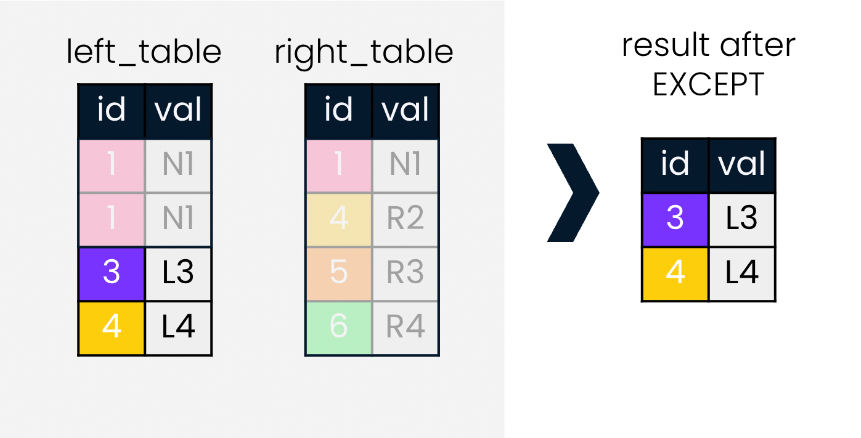
The syntax for the EXCEPT operation is straightforward:
SELECT column1, column2, ...
FROM table1
EXCEPT
SELECT column1, column2, ...
FROM table2;
Explanations:
- Perform a
SELECTstatement on the first table. - Perform a
SELECTstatement on the second table. - Use
EXCEPTto exclude matching records from the right table.
Examples for EXCEPT
Let's say we want to find monarchs who do not also hold the title of prime minister. The EXCEPT operation can be used for this purpose.
SELECT monarch, country
FROM monarchs
EXCEPT
SELECT prime_minister, country
FROM prime_ministers;
Output:
| monarch | country |
|---|---|
| Queen Elizabeth | United Kingdom |
| King Felipe | Spain |
| King Willem | Netherlands |